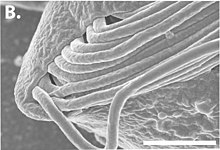Cthulhu macrofasciculumque
| Cthulhu macrofasciculumque | ||||||||||||
|---|---|---|---|---|---|---|---|---|---|---|---|---|

Cthulhu macrofasciculumque |
||||||||||||
| Systematics | ||||||||||||
|
||||||||||||
| Scientific name of the genus | ||||||||||||
| Cthulhu | ||||||||||||
| James & Keeling, 2012 | ||||||||||||
| Scientific name of the species | ||||||||||||
| Cthulhu macrofasciculumque | ||||||||||||
| James & Keeling , 2012 |
Cthulhu macrofasciculumque is a type of protist within the Parabasalia . It lives as an endosymbiont in the intestines of the termite species Prorhinotermes simplex, which is nativeto Cuba . It is the only known species of the genus Cthulhu .
The species and genus described in 2012 were named after the fictional being Cthulhu from the story Cthulhus Ruf ( Call of Cthulhu ) by HP Lovecraft .
features
Cthulhu macrofasciculumque is a unicellular living being. It is a small flagellate with a length of 17 to 24 μm and a width of 7 to 12 μm and a single cell nucleus at the front end, which is adjacent to a pronounced axostyle . This runs through the entire cell and ends in a pointed part at the rear end of the cell. At the front end there is also a conspicuous bundle of around 20 flagella , which move synchronously and alternately curl up forwards to form a firm bundle and then flap backwards, breaking up into individual flagella.
Way of life
Cthulhu macrofasciculumque lives as an endosymbiont and part of the intestinal flora in the intestines of the termite species Prorhinotermes simplex, which is native to Cuba . The cells move through the alternating rolling up and subsequent flapping of the bundle of flagella at the front end of the cell.
Systematics
The genus Cthulhu and the species Cthulhu macrofasciculumque contained therein was described by Erick R. James and Patrick J. Keeling in 2012 together with the likewise new species Cthylla microfasciculumque . Both species were assigned to the Parabasalia , with the closest relatives also living in termites.
The genus was named after the fictional and tentacle-headed creature Cthulhu from the story Cthulhus Ruf ( Call of Cthulhu ) by HP Lovecraft because of the flagella bundles described by the authors, which give the unicellular an appearance similar to the creature. In the first description, the authors also emphasize that the name can probably not be pronounced correctly due to the extraterrestrial origin and state the usual pronunciation as “ke-thoo-loo”. The species name, however, refers to the large bundle of flagella itself ( macrofasciculumque from "macro" and "fasciculumque").
supporting documents
- ↑ a b c d Erick R. James, Noriko Okamoto, Fabien Burki, Rudolf H. Scheffrahn, Patrick J. Keeling: Cthulhu Macrofasciculumque ng, n. Sp. and Cthylla Microfasciculumque ng, n. sp., a Newly Identified Lineage of Parabasalian Termite Symbionts. PLOS, March 18, 2013; doi : 10.1371 / journal.pone.0058509
literature
- Erick R. James, Noriko Okamoto, Fabien Burki, Rudolf H. Scheffrahn, Patrick J. Keeling: Cthulhu Macrofasciculumque ng, n. Sp. and Cthylla Microfasciculumque ng, n. sp., a Newly Identified Lineage of Parabasalian Termite Symbionts. PLOS, March 18, 2013; doi : 10.1371 / journal.pone.0058509

